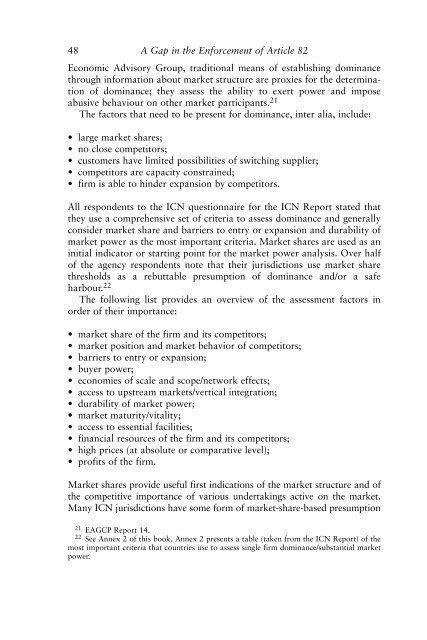Abuse of Economic Dependence - The Centre for European Policy ...
Abuse of Economic Dependence - The Centre for European Policy ...
Abuse of Economic Dependence - The Centre for European Policy ...
You also want an ePaper? Increase the reach of your titles
YUMPU automatically turns print PDFs into web optimized ePapers that Google loves.
48 A Gap in the En<strong>for</strong>cement <strong>of</strong> Article 82<br />
<strong>Economic</strong> Advisory Group, traditional means <strong>of</strong> establishing dominance<br />
through in<strong>for</strong>mation about market structure are proxies <strong>for</strong> the determination<br />
<strong>of</strong> dominance; they assess the ability to exert power and impose<br />
abusive behaviour on other market participants. 21<br />
<strong>The</strong> factors that need to be present <strong>for</strong> dominance, inter alia, include:<br />
• large market shares;<br />
• no close competitors;<br />
• customers have limited possibilities <strong>of</strong> switching supplier;<br />
• competitors are capacity constrained;<br />
• firm is able to hinder expansion by competitors.<br />
All respondents to the ICN questionnaire <strong>for</strong> the ICN Report stated that<br />
they use a comprehensive set <strong>of</strong> criteria to assess dominance and generally<br />
consider market share and barriers to entry or expansion and durability <strong>of</strong><br />
market power as the most important criteria. Market shares are used as an<br />
initial indicator or starting point <strong>for</strong> the market power analysis. Over half<br />
<strong>of</strong> the agency respondents note that their jurisdictions use market share<br />
thresholds as a rebuttable presumption <strong>of</strong> dominance and/or a safe<br />
harbour. 22<br />
<strong>The</strong> following list provides an overview <strong>of</strong> the assessment factors in<br />
order <strong>of</strong> their importance:<br />
• market share <strong>of</strong> the firm and its competitors;<br />
• market position and market behavior <strong>of</strong> competitors;<br />
• barriers to entry or expansion;<br />
• buyer power;<br />
• economies <strong>of</strong> scale and scope/network effects;<br />
• access to upstream markets/vertical integration;<br />
• durability <strong>of</strong> market power;<br />
• market maturity/vitality;<br />
• access to essential facilities;<br />
• financial resources <strong>of</strong> the firm and its competitors;<br />
• high prices (at absolute or comparative level);<br />
• pr<strong>of</strong>its <strong>of</strong> the firm.<br />
Market shares provide useful first indications <strong>of</strong> the market structure and <strong>of</strong><br />
the competitive importance <strong>of</strong> various undertakings active on the market.<br />
Many ICN jurisdictions have some <strong>for</strong>m <strong>of</strong> market-share-based presumption<br />
21 EAGCP Report 14.<br />
22 See Annex 2 <strong>of</strong> this book. Annex 2 presents a table (taken from the ICN Report) <strong>of</strong> the<br />
most important criteria that countries use to assess single firm dominance/substantial market<br />
power.


